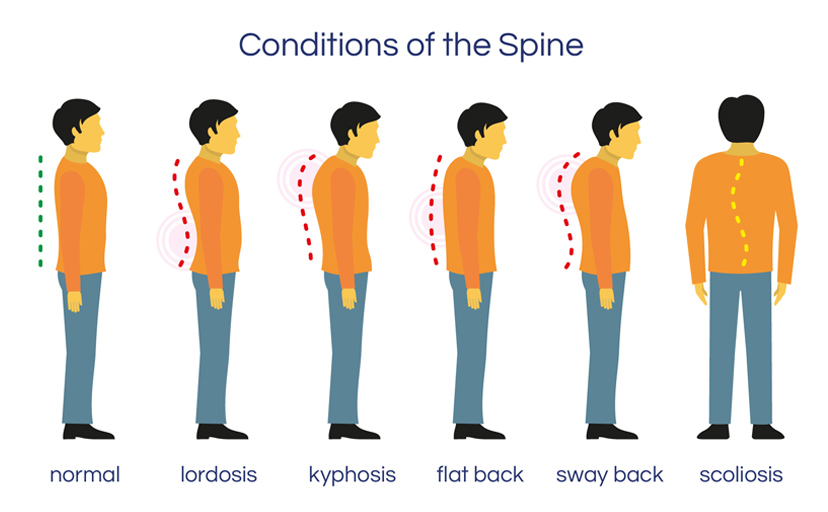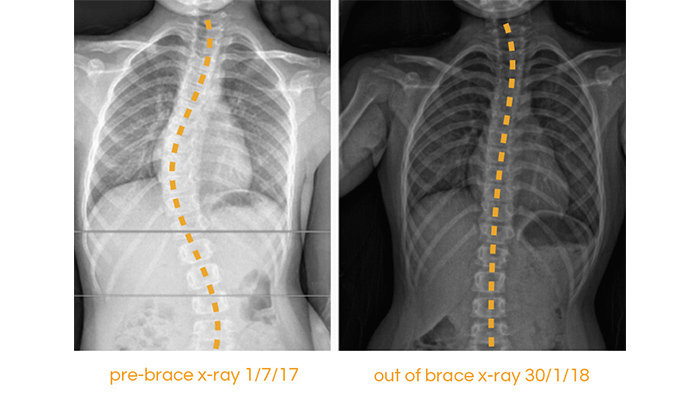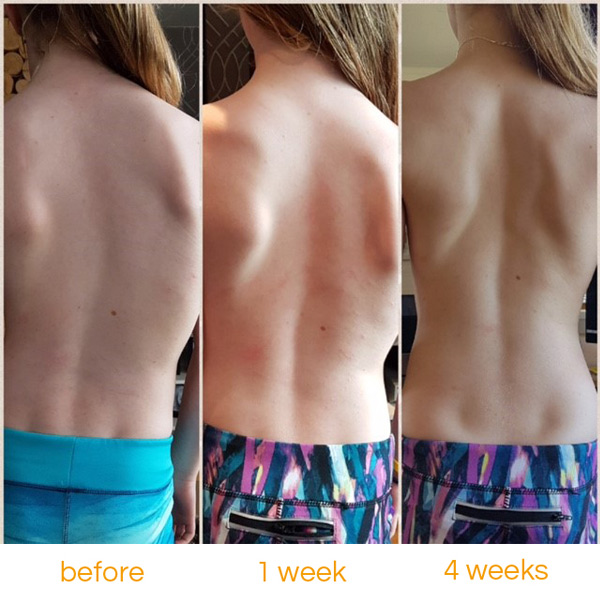A normal spine will have a gentle ‘S’ shape when seen from the side. Naturally, the neck will arch forwards slightly and the lower back (lumbar part of the spine) does the same, also known as lordosis. The thoracic part of the spine (between the shoulder blades) has a slight outward curve, and this is known as kyphosis. A normal back has a 20° to 45° curvature in the upper part of the back, yet anything above 45° is called kyphosis. Kyphosis can cause pain if excessive or if in the wrong place such as the lower back.
Kyphosis refers to excessive curvature of the spine usually present between the shoulder blades, where it curves further backwards than it should. This can cause a person to become more round-shouldered, unable to stand up straight and can cause pain. Kyphosis is broadly characterised as either postural; i.e. caused by poor posture, or structural; caused by a bone, disc, nerve, ligament or muscle abnormality.
For adults, it can be caused by the degeneration of discs and joints of the spine, or as a result of secondary conditions like osteoporosis and Parkinson’s disease. In children, it can be a result of spina bifida. Diagnosis is based on a physical exam.

In young children and adolescents with kyphosis, the most common form is Scheurmann's disorder, sometimes called Scheurmann's disease, characterised when growth spurts occur and the rectangular-shaped vertebrae become compressed and wedged into triangles. With Scheuermann’s, the thoracic curve will typically be between 45° and 75°.
Scheuermann’s is a hyper kyphosis, a more serious deformity than postural kyphosis as the bones have already wedged and deformed. Symptoms can develop between the ages of 10 and 15. Patients with the condition may have a visual ‘hunchback’ and can experience lower or mid-level back pain or neck pain.

Bracing can provide pain relief for those suffering from kyphosis by adjusting the position of the shoulders and pelvis. In the growing patient, we can prevent worsening of the deformity and quickly improve appearance. A bespoke physiotherapy treatment programme, based upon pattern-curve specific Schroth principles, can be used to treat postural Kyphosis, Osteoporosis and Scheuermann’s disease. The programme will aim to improve muscle lengths and spinal extensor strength while reducing postural pain.
Read more about:


Among 14 to 17-year-old cricket players, there is an increased risk of pars stress fracture, or spondylolysis, which can cause lower back pain and reduced mobility. These athletes are at high risk due to their still-developing bones, which struggle to cope with the repetitive stress of fast bowling.

Apprentice orthotist Catherine Hendy’s journey into the world of prosthetics and orthotics began in an unconventional way. After completing a degree in art, she then trained as an orthotics technician, before taking up an apprenticeship to become a clinician. Now, she’s been nominated for the British Association of Prosthetists and Orthotists (BAPO) Student of the Year 2024.

Amelia was diagnosed with tightness in her neck by her GP before her plagiocephaly diagnosis. Clinician Jo Drake treated her with a LOCband Lite cranial remoulding helmet, which improved her overall head shape and asymmetry.

What are lower limb orthotics, and how can they improve mobility and reduce pain? We've put together this summary of the different kinds of lower limb orthotics, from AFOs and KAFOs to more complex orthotics like RGOs, and how they can help patients with their mobility goals.

Barney's very severe flat head syndrome (plagiocephaly) and diagnosis of torticollis led to successful helmet therapy with the LOCband, significantly improving his head shape, going from 27mm asymmetry to 12mm.

“It’s life-changing, my swimming coach has even remarked what a difference my treatment has made" Read how pectus bracing treatment helped to correct Aris' complex chest deformity, involving a combination of pectus excavatum, pectus carinatum and rib flaring.

Cerebral palsy patient Lucas sees significant improvement in his walking after only six months in his new custom Ankle Foot Orthoses (AFOs), designed by Professor Saeed Forghany in our Manchester clinic. Hear how a detailed gait analysis and bespoke AFOs significantly improved Lucas's gait and comfort.

Freddie’s positional plagiocephaly was treated successfully with the LOCBand Lite, going from 11mm to 2mm after four months in his helmet.